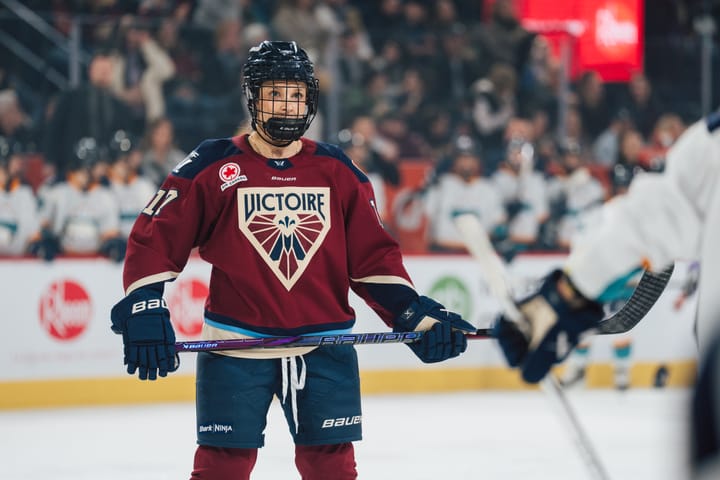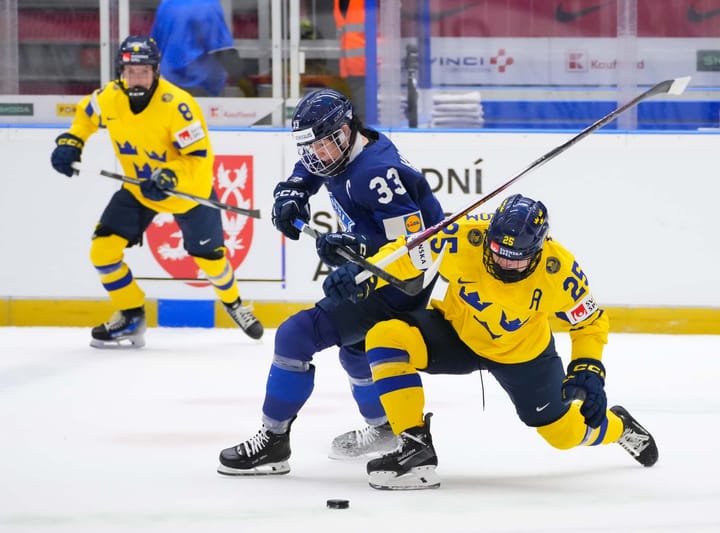Overlooked performances on the 2021 Toronto Six
Why Emma Woods, Taylor Woods, and Breanne Wilson-Bennett deserve more attention for the way they played this year
Today, we’re continuing our series of overlooked performances from each NWHL team from the 2021 season. We have the new kids on the block, the Toronto Six.
There were a lot of special performances on the Six but none greater than Mikyla Grant-Mentis’ MVP campaign that resulted in her piling up four NWHL awards. Bottom line: she’s a franchise player and deserves all the recognition and praise she’s received. With that said, the Six were so much more than a one-player team. Actually, I’d argue that they were second in forward depth behind only the Boston Pride. And, although they exited in the semifinal at the hands of Boston, I consider the Six to be the second-best team we saw in the NWHL this year.
Emma Woods
Woods was out of Toronto’s lineup for the last two games in Lake Placid after catching COVID. That time out of the lineup made her an afterthought for some fans and media members in New York, especially when the focus shifted to the outbreak of COVID and Toronto’s strong finish.
When she was in the lineup in Lake Placid and in the Isobel Cup semifinal, Woods was a key playmaker for the Six. In Lake Placid, she picked up four assists — two at evens and two on the power play — in four games to go along with 22 shots on goal. Her most memorable assist was undoubtedly her first. Woods set up Lindsay Eastwood for the first goal in Six franchise history.
An investigation of the Six’s underlying numbers reveals that Woods was one of their most impactful and important forwards. She averaged 19:59 TOI/GP and led all Six players with 3:55 PP TOI/GP. Chances are, she saw all of that ice time — especially on the advantage — because of her ability to make plays. Woods led all Toronto skaters with a 90 percent passing rate and was an excellent puck carrier through the neutral zone. She was one of the players who helped define Toronto’s downhill attack, which played to the strength of forwards like Grant-Mentis, Breanne Wilson-Bennett, and Brooke Boquist.
If I had to boil down Woods’ game to a single word, I’d say she was cerebral. She’s a great passer, puck carrier, and has great discipline and positioning. Woods finished Lake Placid with two penalties drawn and, all told, averaged 5.2 SOG/GP. That’s a pretty high clip for a player who definitely thinks pass first but it also demonstrates just how important she was to Toronto’s attack.
Woods has now had successful campaigns in the CWHL, SDHL, and NWHL since graduating from Quinnipiac University. I think we can safely call her a quality pro hockey player.
Breanne Wilson-Bennett
Wilson-Bennett quickly became on my favorite players to watch with the puck this year. Her speed and slick hands made her a handful for defenders in the NWHL, which resulted in her drawing a league-leading eight penalties and a penalty shot she failed to cash in on against Lovisa Selander of the Boston Pride.
When she has space in front of her, Wilson-Bennett can tap into a gear that few skaters have in their arsenal. She also has the edgework and ability to drive around and even through defenders, which led to all of those drawn penalties and several big scoring chances. That instinct to go hard to the net also resulted in Wilson-Bennett scoring in the Isobel Cup semifinal against the Pride. All told, she buzzsawed her way to 20 scoring chances this year, which was second only to Grant-Mentis on the Six.
The Colgate alumna made her biggest mark at even strength. She piled up five of her six points — three of which were primary — at evens. Her lone point on the advantage was her first career NWHL goal, scored against the Minnesota Whitecaps.
One last number that speaks to her role and value to Toronto was her average ice time of 20:22 TOI/GP. That was second only to captain Shiann Darkangelo, who happened to be Toronto’s top center. Wilson-Bennett also lined up at center for the Six. She finished Lake Placid with a 58.02 percent success rate on the dot — just one more layer to her game.
Taylor Woods
Woods scored four goals on 19 shots in her first year of NWHL hockey. That’s damn impressive for a defender, especially for one who scored six goals in 74 games in her CWHL career — note: we don’t have iSOG data for the CWHL. But that unsustainable 21.05 shooting percentage is not the reason she made this list. She’s here because her value to Toronto, a team defined by its attack and forward depth, was immense in all three zones.
She and Lindsay Eastwood were an amazing top pair. They got a lot of attention for the impact they had in the offensive zone but I don’t think enough has been said about what Woods, in particular, did off of the puck. Her defensive awareness got the Six out of several jams and she saved at least one goal with quick stickwork and great positioning. Woods was also instrumental to Toronto’s transition game. She led the team with 38 breakouts and was tied for second on the team in entries via stickhandling (25).
Woods led all Six skaters in average ice time (24:57 TOI/GP), takeaways (74), takeaways in the defensive zone (50), scoring chances among defenders (10), and shot attempts among defenders (43). Oh, and yeah, she also scored those four goals. Woods did everything for Toronto. She was a workhorse who could do it all.
Woods was one of the players who exceeded my expectations the most this year. Toronto needed her and Eastwood to be brilliant and they both delivered and then some. Honestly, I don’t think it’s a stretch to say that Woods played some of the best hockey of her life with the Six this year. Chances are, I severely underrated her heading into Lake Placid but I am definitely a believer now. Her ability to read the play made her a threat to join the rush, creep in from the point in the o-zone, and spark Toronto’s transition game.
She was one of the best defenders in the league this year.
Data courtesy of InStat, TheirHockeyCounts.com, and EliteProspects.com.





Comments ()